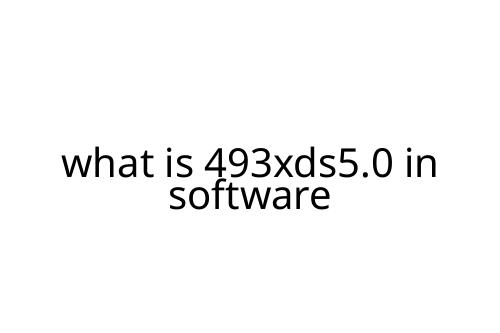what is 493xds5.0 in software
The term "493xds5.0" in software isn't widely recognized in mainstream development circles, but its presence online has raised questions for developers, IT professionals, and curious users alike. If you've stumbled across "493xds5.0," you’re likely trying to determine if it's a genuine software component, an error code, or something else entirely. This article breaks down what we know about it, common scenarios where it might appear, and how you should approach it.
Understanding 493xds5.0: Fact or Red Herring?
Let’s address the big question: what exactly is 493xds5.0 in software? To date, there’s no documented library, platform, or major tool with this precise identifier. Major software registries, package indexes, and documentation sites don’t list it as an official version or product release. This suggests "493xds5.0" is not a standard or commonly used software term.
However, similar alphanumeric strings sometimes show up as internal version codes, error identifiers, firmware models, or placeholders in software documentation or logs. In rare cases, unusual strings like 493xds5.0 might be used by niche tools, legacy systems, or proprietary in-house applications.
Where Might You Encounter 493xds5.0?
If you’ve seen 493xds5.0, it could have appeared in several contexts:
- Software Logs: Some low-level applications or self-made utilities may write obscure codes while logging events or crashes.
- Documentation: Old or auto-generated documentation may use placeholder strings in version fields.
- Malware or Suspicious Software: Sometimes, random strings are embedded by malware authors to obfuscate files or version info.
- Typographical Error: It’s also possible that “493xds5.0” is a typo or corrupted copy-paste of a legitimate software version.
Before taking any drastic measures, check the source and context where you found it.
How to Handle Unknown Software Identifiers
Unrecognized software identifiers deserve caution. Here are a few practical steps:
- Search the Context: Look at the file name, log, or documentation around 493xds5.0 for clues about its purpose.
- Scan for Malware: If you see the term in running processes or unknown files on your computer, run a full malware scan.
- Ask Your Team: In enterprise environments, check with other developers or IT staff to see if anyone recognizes the code.
- Double-Check for Typos: If you’re following instructions and see 493xds5.0 listed, confirm there isn’t a typo in the documentation.
Pros, Cons, and Final Observations
Pros:
- Placeholder codes like 493xds5.0 can help draw attention to missing or incomplete documentation.
- Such strings sometimes help identify development or testing builds.
Cons:
- Lack of documentation can waste time during troubleshooting.
- Unknown strings could signal deeper issues, such as security risks or poor maintenance.
Bottom Line
If you’re wondering what is 493xds5.0 in software, it’s most likely a placeholder, typo, or obscure internal identifier. Double-check your sources, keep your systems secure, and—when in doubt—ask for clarification before acting on instructions referencing unfamiliar software codes.

